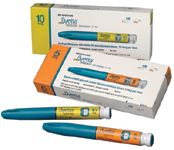Incretin mimetic therapy: Incremental for diabetes
Now Type 2 diabetics will have another option for controlling blood glucose. Exenatide (Byetta, Amylin Pharmaceuticals) injection can now be used as add-on therapy in patients who have not achieved adequate blood glucose control on a thiazolidinedione (TZD). The drug was approved by the Food & Drug Administration for expanded combination use in December.

The approval was based on results of a 16-week clinical trial, in 233 patients, designed to evaluate use of exenatide in combination with a TZD, with or without metformin. The results were presented at the 66th Annual Scientific Sessions of the American Diabetes Association (ADA) last year, following submission of a supplemental New Drug Application to the FDA in early 2006. The study found 62% of patients treated with exenatide as a combination therapy achieved an A1c level of 7% or less, compared with 16% in the control group.

According to Amylin, patients in the study with combination use of exenatide and a TZD also showed improvements in fasting blood glucose and postprandial blood glucose in addition to the favorable A1c levels. Specifically, patients treated with exenatide had an average fasting glucose of 27 mg/dL lower than the control group, measured before breakfast. Exenatide also significantly reduced the average two-hour post-meal glucose surges following breakfast and dinner by 34 mg/dL from baseline.
"Exenatide enhances glucose-dependent synthesis of insulin, decreases hepatic glucose output, regulates gastric emptying, and decreases food intake, which can also result in weight loss," Smith pointed out. In fact, patients in the exenatide arm of the clinical trial showed an average weight reduction of 3.3 pounds compared with an average weight reduction of 0.4 pounds in the control arm.
The most common adverse event seen in the trial was mild to moderate dose-dependent nausea, which was reported by about 40% of patients in the exenatide group, compared with only 15% in controls. According to the manufacturer, the frequency and severity of nausea decreased over time in most patients. Rates of mild and moderate hypoglycemia were similar between the exenatide and placebo treatment groups. No severe hypoglycemia was reported.
Exenatide was previously approved as adjunctive therapy to improve glycemic control in patients with Type 2 diabetes mellitus who are taking metformin, a sulfonylurea, a thiazolidinedione, a combination of metformin and a sul-fonylurea, or a combination of metformin and a thiazolidinedione, but have not achieved adequate glycemic control. The drug represents the first FDA-approved incretin mimetic, which works by mimicking the glucose-lowering effects of incretins, which are naturally occurring hormones.
So which type of patient might be best suited for exenatide? "An overweight Type 2 diabetes patient currently being treated with oral medications, but who has not achieved glycemic goals," said Smith. "A patient who is resistant to insulin could also benefit from exenatide therapy."
Targeted Drug Combination Reveals New Activity in Brain Tumors
December 28th 2021A combination of two targeted cancer drugs showed unprecedented, “clinically meaningful” activity in patients with highly malignant brain tumors that carried a rare genetic mutation, according to a clinical trial report by investigators from Dana-Farber Cancer Institute.